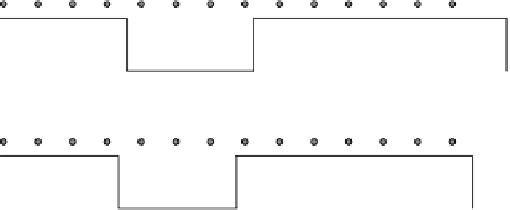Global Positioning System Reference
In-Depth Information
Sampling
(a) Original code.
(b) Code with positive Doppler frequency.
(c) Equivalent effect on the sampling time.
FIGURE 11.4
Effect of Doppler on the C/A code.
expressed as in Equation (10.18),
f
s
1
−
f
s
f
L
1
f
L
1
+
f
d
≈
f
d
f
L
1
f
se
=
or
(
11
.
1
)
t
s
1
+
1
f
se
=
t
s
(f
L
1
+
f
d
)
f
d
f
L
1
t
se
=
=
f
L
1
where
f
s
=
5 MHz is the original sampling frequency,
f
L
1
=
1575
.
24 MHz is
the
L
1 frequency,
f
d
is the Doppler frequency,
t
s
1/
f
s
and
t
se
are the original
and equivalent sampling times. It should be noted that this equation is different
from Equations (10.17) and (10.18). The two equations in the previous chapter
calculate the C/A code length change; thus, a positive Doppler will result in code
length shrink. A one ms long code will have an effective length of smaller than
1 ms. In Equation (11.1) the equivalent sampling frequency
f
se
is decreased or
the equivalent time
t
se
is increased. By this effective sampling frequency, the
desired digitized data can be obtained.
Now let us discuss the generation of a C/A code with any initial code phase.
The term offset time (
t
of
) is used for the initial C/A code phase. The offset time
can only be a positive value in the actual program. If the offset time is shifted
to the right, it is considered as a positive value, as shown in Figure 11.5. If the
offset time is shifted to the left it is considered a negative value. The negative
value can be represented by an equivalent relatively long positive offset as shown
in the figure. The offset time
t
of
is also affected by the Doppler frequency, and
the equivalent offset time
t
ofe
canbeexpressedas
=
t
of
(f
L
1
+
f
d
)
t
ofe
=
(
11
.
2
)
f
L
1






















Search WWH ::

Custom Search